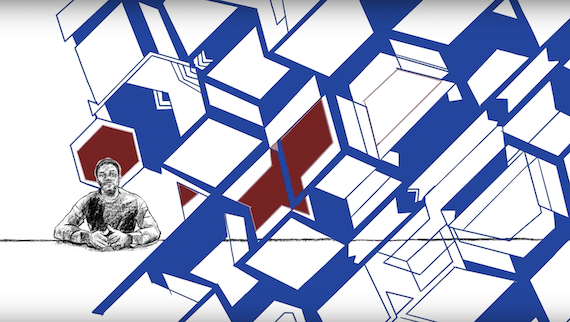In the midst of the 2020 pandemic and isolation, a creative call to action was made by UWinnipeg’s Centre for Research in Cultural Studies (CRiCS) led by director Dr. Angela Failler along with CRiCS member Dr. Jane Barter.
The impetus was to bring greater articulacy to observations and analyses surrounding COVID-19. The duo co-edited a timely online series titled COVID-19 and Cultural Studies: Articulating the Pandemic.
The imaginative exercise in recollection was rewarding and convinced me that impressions—some kind of abstract fancies—might offer something closer to my state of mind and the atmosphere of the writing.
Dr. Arthur Chigbo Anyaduba
One of the first contributors was UWinnipeg’s Dr. Arthur Chigbo Anyaduba. Anyaduba, an assistant professor in English, wrote Becoming Pandemic: Dwelling in a Lockdown, a piece exploring his personal experience as a researcher during the COVID-19 pandemic.
Since then, his original work was converted into a graphic recording version thanks to a creative collaboration with UWinnipeg alumna Devon Kerslake, a graphic facilitator at ThinkLink Graphics and graduate of the Masters in Cultural Studies at UWinnipeg, and an initial introduction by Failler.
To help guide the graphics, Kerslake asked Anyaduba to go back to his mindset and surroundings when he wrote the original text.
“The imaginative exercise in recollection was rewarding and convinced me that impressions—some kind of abstract fancies—might offer something closer to my state of mind and the atmosphere of the writing,” said Anyaduba.
In the finished Becoming Pandemic: Dwelling in a Lockdown graphic recording, one can see Kerslake’s interpretation of these impressions.
Animated illustrations created new layers of meaning and highlight certain portions of the piece, with colour and movement reinforcing the emphases Anyaduba makes in his narration.
“As each illustrated section unfolds, my intention is for the viewer to get lost in the meandering visual while listening more deeply,” said Kerslake.
Said Anyaduba: “The graphic recording tells its own complex story: of someone stuck in a place as life, like impressions, happen all about, of figures and abstract forms that insist on being read by anyone who can.” He added that, “besides the visual accomplishments of the graphic recording as a beautiful work of art, I feel it triumphs even more as an artistic interpretation of a dissonant reflection.”
Kerslake also found the collaborative process fulfilling. “It was such an honour to provide visuals to his ideas,” she said, “and it was cathartic for me to return to his thoughts from 2020 and breathe new perspectives into that memory.”
This wasn’t the first CRiCS graphic recording. In December 2020, Kerslake also worked with Amanda Carvalho, a fellow alumna of the UWinnipeg Masters in Cultural Studies program, to render her original contribution to the CRiCS COVID-19 series, Between Boxes, as a graphic recording.
“These projects make clear the benefits that creative forms of research and knowledge dissemination such as graphic recording bring to cultural studies specifically and to academic scholarship more generally,” said Failler. “I’m thrilled to be able to facilitate this kind of work, which shows off the incredible ideas and talents of our students, faculty, and alumni.”
To get the full impact of this media, visit the CRiCS website and enjoy the graphic recordings as well as the original written texts with voice over.



